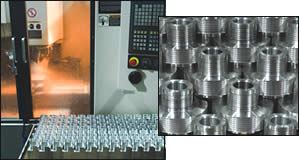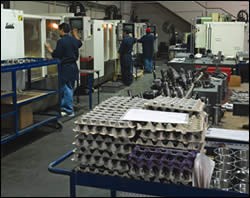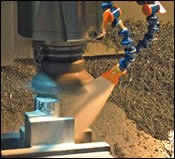Cutting Hard And Soft Materials Quickly With Versatile VMC
By the very nature of their business, contract machining shops are constantly looking for ways to sharpen their capabilities and reduce costs to quote jobs more competitively. Price, along with quality and delivery, can contribute to a winning recipe.
Share





By the very nature of their business, contract machining shops are constantly looking for ways to sharpen their capabilities and reduce costs to quote jobs more competitively. Price, along with quality and delivery, can contribute to a winning recipe.
Southern California’s Fontal Controls is one example of a shop that constantly searches for new ways to maintain a competitive advantage in a crowded field. With this mindset, the shop set an agenda calling for the capability to cut steel as hard as 47/48 Rc quicker and more effectively. In addition, the company says it wanted to rough aluminum faster to make detailed cuts on contoured parts without stalling the tool. Also, running at higher feed rates without breaking tools would enable fewer passes, thereby further reducing part costs. Other goals included improving surface finishes, reducing tool changes and eliminating clean-up operations, all of which would require less machine vibration. A new machine would need to be rigid enough to reduce vibration and cost-effective enough to justify the shop’s investment.
With these objectives in mind, Fontal Controls acquired a VMC designed with a rigid boxway construction and equipped with an 8,000-rpm spindle. The machine, a VMC 3016FX, was designed and built by Chatsworth, California-based Fadal Machining Centers. Fontal now says its revenues have increased because of this machine’s fast cycle times.
Oscar Fontal founded the company in the early 1980s with just one machine. The company grew quickly by focusing on precision CNC machining and turning of components for the die and mold, machine tool and aerospace industries. In addition to these operations, the shop also performs grinding and other finishing work. Dimensional inspection and surface-finish inspection are carried out in-house.
In 1994, Fontal moved to a 14,000-square-foot facility in Sylmar, California, which is near Los Angeles. Today, the founder’s sons run the company as partners. Seven of the company’s 16 CNC machines are VMCs that can accommodate workpieces measuring as large as 24 by 48 inches. Of those seven VMCs, six were designed and built by Fadal.
Although the machining programs and cycle times vary, Fontal says the new VMC has increased parts-per-hour productivity by more than 40 percent compared to the previous machine. On one large, complex aluminum aerospace part, for example, spindle speed on deep profiling jumped from 5,500 rpm to 7,000 rpm. The feed rate also increased to 100 inches per minute—nearly triple the rate on the older machine.
To machine these aluminum aerospace parts, the company takes 1.260-inch-deep rough-cut passes with a 1-inch-diameter, coarse-tooth rougher. The cycle time on the rough, deep-cut operation was reduced from more than 9 minutes to approximately 6 minutes. Total machining time dropped from 79 to 54 minutes. In fact, revenues on the new machine alone increased by more than 46 percent per day.
Recently, the company ran a batch of 147 of these parts without any cutter compensation. Fontal programmer and machinist Art Martinez says this is a testament to the machine’s rigidity, and he estimates that repeat batches throughout the year will yield substantial cumulative savings for the customer. Another benefit is that this capability will “open the doors” for the company to gain larger-part work.
Mr. Martinez says that Fontal has also achieved faster drilling and milling cycles on 15-5 heat-treated, 42-Rc steel, as evidenced by a recent job machining an adaptor part.
Spindle speed and rigidity are the two biggest attributes that persuaded Fontal to purchase the 3016FX. The machine’s cast iron, boxway construction is designed to provide large surface-area contact on the integral, flame-hardened ways. This helps maintain rigidity by damping vibration during heavy cuts. According to the manufacturer, accuracies stay high and predictable on circular features, and reversal error is virtually eliminated.
The machine features XYZ axis travels of 30 by 16 by 20 inches (762 by 407 by 508 mm). The VMC is part of a family of three Fadal models. These include the 2216FX, which features a smaller envelope, and the 4020FX, which has axis travels of 40 by 20 by 20 inches (1,106 by 508 by 508 mm).
A maximum deviation of 0.000232-inch roundness has been verified with a standard ballbar test (ASME B5.54), the company says. Accuracy is also enhanced by increased stiffness resulting in part from the Steinmeyer ETA+ dual-mounted ballscrews. Fontal says its part programmers and machinists are receptive to the Fadal GE Fanuc Oi-MC control because they are already familiar with the Fanuc controls on other machines in the shop. The company also cites an intuitive interface and expanded functions as factors in simplifying part setups. In addition, the machine is equipped with a 21-tool ATC, which is suited to Fontal’s type of work.
“The rigidity of the Fadal machine is important to our part finishes,” says Cristian Fontal, managing partner and controller. “The ballscrews are fast and offer accuracy. The machine affords us the versatility to cut both steel and aluminum quickly and accurately.”
Related Content
Ballbar Testing Benefits Low-Volume Manufacturing
Thanks to ballbar testing with a Renishaw QC20-W, the Autodesk Technology Centers now have more confidence in their machine tools.
Read MoreInside the Premium Machine Shop Making Fasteners
AMPG can’t help but take risks — its management doesn’t know how to run machines. But these risks have enabled it to become a runaway success in its market.
Read MoreHow to Determine the Currently Active Work Offset Number
Determining the currently active work offset number is practical when the program zero point is changing between workpieces in a production run.
Read MoreQuick-Change Tool Heads Reduce Setup on Swiss-Type Turning Centers
This new quick-change tooling system enables shops to get more production from their Swiss turning centers through reduced tool setup time and matches the performance of a solid tool.
Read MoreRead Next
5 Rules of Thumb for Buying CNC Machine Tools
Use these tips to carefully plan your machine tool purchases and to avoid regretting your decision later.
Read MoreRegistration Now Open for the Precision Machining Technology Show (PMTS) 2025
The precision machining industry’s premier event returns to Cleveland, OH, April 1-3.
Read MoreSetting Up the Building Blocks for a Digital Factory
Woodward Inc. spent over a year developing an API to connect machines to its digital factory. Caron Engineering’s MiConnect has cut most of this process while also granting the shop greater access to machine information.
Read More




























.jpg;maxWidth=300;quality=90)







